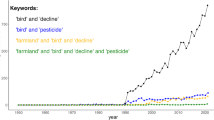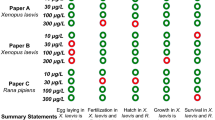Abstract
Ecotoxicology is an emerging field of study that attempts to combine ecological and toxicological principles so that more realistic estimates of environmental damage by xenobiotics can be made. However, ecotoxicology is dominated by toxicology, and calls to ‘put the ecology into ecotoxicology’ have been virtually ignored (Baird et al., 1996).
Access this chapter
Tax calculation will be finalised at checkout
Purchases are for personal use only
Preview
Unable to display preview. Download preview PDF.
Similar content being viewed by others
References
Allan, J.D. (1976) Life history patterns in zooplankton. American Naturalist, 110 165–180.
Allan, J.D. and Daniels, R.E. (1982) Life table evaluation of chronic exposure of Eurytemora affinis (Copepoda) to kepone. Marine Biology, 66 179–184.
Baird, D.J., Maltby, L. and Douben, P.E.T. (1996) Ecotoxicology: Ecological Dimensions, Chapman & Hall, London.
Bakker, F.M. and Jacas, J.A. (1995) Pesticides and phytoseiid mites: strategies for risk assessment. Ecotoxicology and Environment Safety, 32 58–67.
Banken, J.A.O. (1996) An ecotoxological assessment of the neem insecticide, Neemix, on the pea aphid, Acyrthosiphon pisum Harris, and the seven-spotted lady beetle, Coccinella septempuntata L. Masters thesis.
Bechmann, R.K. (1994) Use of life tables and LC50 tests to evaluate chronic and acute toxicity effects of copper on the marine copepod Tisbe furcata (Baird.). Environmental Toxicology and Chemistry, 13(9), 1509–1517.
Birch, L.C. (1948) The intrinsic rate of natural increase of an insect population. Journal of Animal Ecology, 17, 15–26.
Cairns, J. (1983) Are single species toxicity tests alone adequate for estimating environmental hazard? Hydrobiologia, 100 47–57.
Çilgi, T. and Jepson, P.C. (1992) The use of tracers to estimate the exposure of beneficial insects to direct pesticide spraying in cereals. Annals of Applied Biology, 121 239–247.
Cole, L.C. (1954) The population consequences of life history phenomena. Quarterly Review of Biology, 29 103–137.
Daniels, R.E. and Allan, J.D. (1981) Life table evaluation of chronic exposure to a pesticide. Canadian Journal of Fisheries and Aquatic Science, 38 485–494.
Hassan, S.A. (1992) Guidelines for testing the effects of pesticides on beneficial organisms: description of test methods. IOBC/WPRS Bulletin, XV(3), 1–3.
Kareiva, P., Stark, J.D. and Wennergren, U. (1996) Using demographic theory, community ecology and spatial models to illuminate ecotoxicology, in Ecological Dimensions, (eds L. Maltby and P. Grieg-Smith), Chapman & Hall, London, pp. 13–23.
Kimball, K.D. and Levin, S.A. (1985) Limitations of laboratory bioassays: the need for ecosystem level testing. Bioscience, 35 165–171.
Kjaer, C. and Jepson, P.C. (1995) The toxic effects of direct pesticide exposure for a nontarget weed-dwelling chrysomelid beetle (Gastrophysa polygoni) in cereals. Environmental Toxicology and Chemistry, 14(6), 993–999.
McNair, J.N., Goulden, C.E. and Ziegenfuss, M.C. (1995) Is there a place for ecotoxicology? SETAC News,15(6), 18–21.
Nicholson, A.J. (1954) Compensation reactions of populations to stresses, and their evolutionary significance. Australian Journal of Zoology, 2, 1–8.
Overmeer, W.P.J. and van Zon, A.Q. (1982) A standardized method for testing the side-effects of pesticides on the predacious mite Amblyseius andersoni (Acarina: Phytoseiidae). Entomophaga, 27, 357–364.
Slobodkin, L.B. and Richman, S. (1956) The effect of removal of fixed percentages of the newborn on size and variability in populations of Daphnia pulicaria (Forbes). Limnology and Oceanography, 1, 209–237.
Stark, J.D. and Sherman, M. (1989) Toxicity, penetration and metabolism of acephate in three fruit fly species (Diptera: Tephritidae). Journal of Economic Entomology, 82, 1564–1571.
Stark, J.D. and Wennegren, U. (1995) Can population effects of pesticides be predicted from demographic toxicological studies? Journal of Economic Entomology, 88(5), 1089–1096.
Stark, J.D., Tanigoshi, L., Bounfour, M. and Antonelli, A. (1997) Reproductive potential: it’s influence on the susceptibility of a species to pesticides. Ecotoxicology and Environmental Safety, 37, 273–279.
Walthall, W.K. (1995) An ecotoxicological approach to the assessment of the insecticide Imidacloprid on the pea aphid, Acyrthosiphon pisum Harris (Homoptera: Aphididae). Masters thesis, 97 pp.
Walthall, W.K. and Stark, J.D. (1997) Comparison of two population-level ecotoxicological endpoints: the intrinsic (rm) and instantaneous (ri) rates of increase. Environmental Toxicology and Chemistry, 16, 1068–1073.
Editor information
Editors and Affiliations
Rights and permissions
Copyright information
© 1998 Springer Science+Business Media Dordrecht
About this chapter
Cite this chapter
Stark, J.D., Banken, J.A.O., Walthall, W.K. (1998). The importance of the population perspective for the evaluation of side-effects of pesticides on beneficial species. In: Haskell, P.T., McEwen, P. (eds) Ecotoxicology. Springer, Boston, MA. https://doi.org/10.1007/978-1-4615-5791-3_37
Download citation
DOI: https://doi.org/10.1007/978-1-4615-5791-3_37
Publisher Name: Springer, Boston, MA
Print ISBN: 978-1-4613-7653-8
Online ISBN: 978-1-4615-5791-3
eBook Packages: Springer Book Archive




